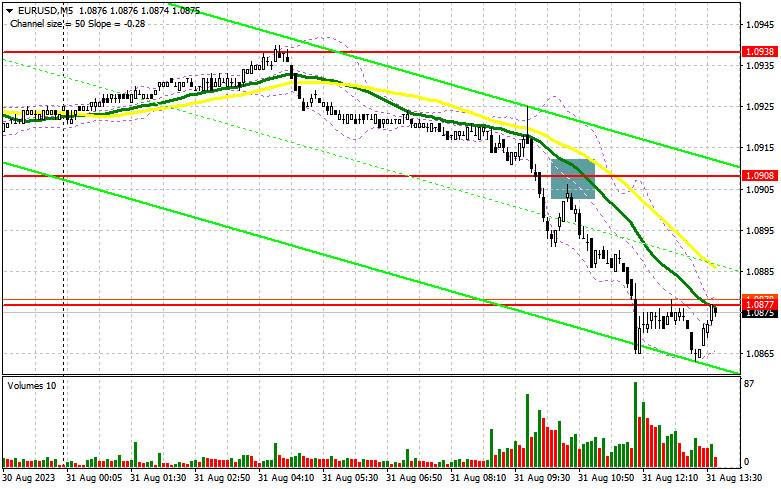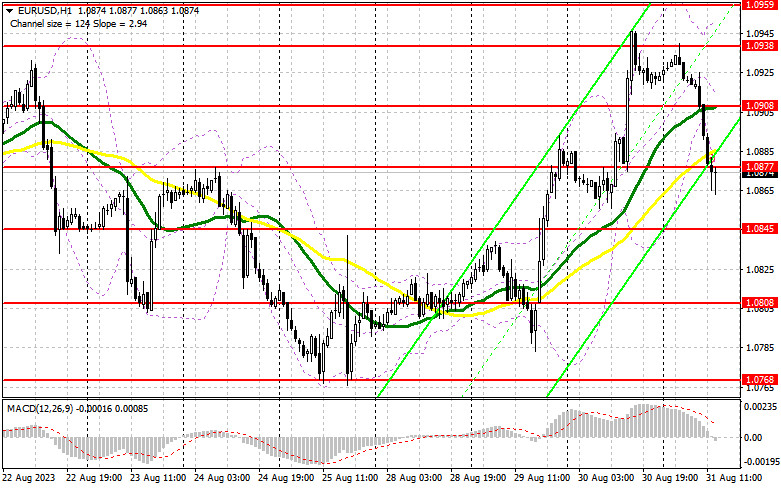
In my morning forecast, I highlighted the 1.0908 level and recommended using it as a reference for market entry decisions. Let's look at the 5-minute chart and see what happened there. The breakthrough and subsequent retest of the 1.0908 level led to a sell signal, dropping the euro by over 30 points. The technical outlook for the afternoon remained unchanged.

To open long positions for EUR/USD:
The recently released inflation data in the Eurozone suggested a weakening stance for the European currency. Although overall inflation remained unchanged, the decline in core inflation, which finally moved in August this year, is of greater importance for the European Central Bank. However, given the current market volatility, it's premature to conclude. Ahead of us lies crucial statistics from the US: figures regarding the core Personal Consumption Expenditures (PCE) index in the US and Americans' spending and income levels. If price pressure persists, the EUR/USD will likely decline.
For this reason, I recommend not rushing to open long positions. An ideal buying scenario would be the formation of a false breakout around the nearest support level at 1.0845, which we haven't reached during the first half of the day. Only there can one find a favorable entry point, expecting a return to an upward tendency that could evolve into a new trend. A key target for bulls now is the 1.0877 resistance, which earlier today acted as support. A break above and subsequent top-down retest of this range would strengthen demand for the euro, giving a chance for a surge to 1.0908. The ultimate target is the 1.0938 area, where I plan to lock in profits. With the possibility of further decline in EUR/USD, strong US statistics, and inactivity around 1.0845, bears might try to regain market control and negate the pair's weekly rise. Only a false breakout around 1.0808 will signal a euro buy in such a case. I will immediately go long on a rebound from 1.0768, targeting an upward correction of 30-35 points within the day.
To open short positions for EUR/USD:
For sellers, the primary task is to defend the 1.0877 resistance, but a lot will depend on US data. Figures indicating sustained price pressure and the PCE index, which the Federal Reserve prefers for inflation measurement, would strengthen the dollar. For this reason, as long as trading is below 1.0877, I expect a further decline in the pair. A false breakout at this level after the data release will be an additional signal to open short positions, targeting a return to 1.0845. Only after a breakthrough and consolidation below this range, followed by a bottom-up retest, do I expect another signal, paving the way to 1.0805, where I anticipate more significant buyers. The ultimate target is the 1.0768 area, where I plan to lock in profits.

In the event of an upward movement of EUR/USD during the American session and a lack of bears at 1.0877, which would only happen in the case of weak inflation data and a sharp decrease in American incomes and expenditures, the bulls will regain control of the market. Given such developments, I will delay short positions until the new resistance at 1.0908. I'll also consider selling there, but only after an unsuccessful consolidation. I will initiate short positions immediately on a rebound from a peak of 1.0938, targeting a downward correction of 30-35 points.
The COT (Commitment of Traders) report dated August 22 showed an increase in both long and short positions. Considering the poor data on the US PMI indices, indicating an economic contraction, and hawkish comments at the Jackson Hole symposium by Federal Reserve Chairman Jerome Powell, it's unsurprising that there were slightly more short positions than long ones. However, paradoxically, the fall of the euro is seen as an attractive moment, and the optimal medium-term strategy under current conditions remains to buy risk assets on a decline. The COT report showed that long non-commercial positions increased by 6,925 to 239,391, while short non-commercial positions jumped by 8,028 to 80,028. As a result, the spread between long and short positions decreased by 3,173. The closing price dropped to 1.0866 from 1.0922, indicating a bearish market.
Indicator signals:
Moving averages:
Trading occurs around the 30 and 50-day moving averages, indicating market confusion.
Note: The author considers the period and prices of moving averages on the H1 hourly chart and differs from the general definition of classical daily moving averages on the D1 daily chart.
Bollinger Bands:
In the event of growth, the upper boundary of the indicator around 1.0945 will act as resistance.
Description of indicators:
• Moving average (defines the current trend by smoothing out volatility and noise). Period 50. It's marked in yellow on the chart.
• Moving average (defines the current trend by smoothing out volatility and noise). Period 30. It's marked in green on the chart.
• MACD Indicator (Moving Average Convergence/Divergence). Fast EMA period 12. Slow EMA period 26. SMA period 9.
• Bollinger Bands. Period 20.
• Non-commercial traders - speculators such as individual traders, hedge funds, and large institutions that use the futures market for speculative purposes and meet specific requirements.
• Long non-commercial positions represent the total long open position of non-commercial traders.
• Short non-commercial positions represent the total short open position of non-commercial traders.
• The total non-commercial net position is the difference between short and long positions of non-commercial traders.